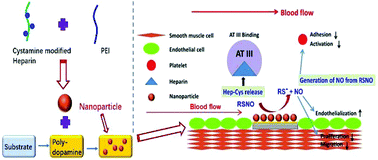Multifunctional coatings that mimic the endothelium: surface bound active heparin nanoparticles with in situ generation of nitric oxide from nitrosothiols†
Abstract
Multifunctional coatings that mimic the endothelial function in terms of nitric oxide generation and membrane-bound active heparin species are prepared via the immobilization of cystamine-modified heparin/polyethyleneimine (Hep-Cys/PEI) nanoparticles. Fourier transform infrared spectra (FTIR) and X-ray photoelectron spectroscopy (XPS) were conducted to confirm the coating formation. Functions of active heparin release and nitric oxide (NO) generation are obtained on the material surface after the immobilization of Hep-Cys/PEI nanoparticles. Moreover, a nanoparticle-immobilized coating is sufficiently flexible to resist the deformation of a 316L SS stent without any destruction. With the introduction of heparin, the antithrombin III (AT-III) binding ability was significantly enhanced with prolonged APTT time. Besides, a Hep-Cys/PEI nanoparticle immobilized coating surface not only significantly suppressed the platelet adhesion and activation, but also promoted EC proliferation and inhibited SMC proliferation. Besides, a milder tissue response was observed on the NP immobilized surface. With the synergistic effect of heparin and nitric oxide generating moieties, such multifunctional coatings presented potential for the modification of vascular materials.



 Please wait while we load your content...
Please wait while we load your content...